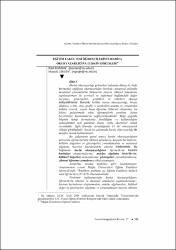| dc.contributor.author | Duman, Bilal | |
| dc.contributor.author | Girgin, Mustafa | |
| dc.date.accessioned | 2020-11-20T17:34:10Z | |
| dc.date.available | 2020-11-20T17:34:10Z | |
| dc.date.issued | 2007 | |
| dc.identifier.issn | 1302-7956 | |
| dc.identifier.issn | 2717-834X | |
| dc.identifier.uri | https://app.trdizin.gov.tr//makale/TmpJM09ERXg | |
| dc.identifier.uri | https://hdl.handle.net/20.500.12809/8027 | |
| dc.description.abstract | Harita okuryazarlığı geleneksel anlamda dünya ile ilişki kurmamızı sağlayan okuryazarlığın ötesinde; durumsal anlamda mantıksal çıkarımlarda bulunarak bireyin zihinsel şemalarını yapılandırması ile evrensel ve toplumsal bağlamdaki değer yargıları, göstergeleri, grafikleri ve ritüelleri okuyup anlayabilmektir. Bununla birlikte harita okuryazarlığı, bireye düşünce, eylem, obje, grafik ve sembolleri anlama ve yorumlama imkânı vererek, yaşam boyu öğrenme bilincini oluşturma, bu bilinci geliştirmede etkin öğrenmelerle problem çözme becerilerini kazanmalarını sağlayabilmektedir. Bilgi çağında bilginin hangi formatlarda üretildiğini ve kullanıldığını anlayabilmek için günümüz insanı çoklu okuryazar olmak zorundadır. İlgili literatür tarandığında 34 tür okuryazarlık olduğu görülmüştür. Ancak bu çalışmada harita okuryazarlığı bir metafor olarak kullanılmıştır. Bu çalışmanın genel amacı harita okuryazarlığının üniversite öğrencilerinin zihinsel şemalarını, kavram haritalarını, kültürel değerleri ve göstergeleri yorumlamaları ve mekânsal algılama becerisi üzerilerindeki etkisini irdelemektir. Bu bağlamda harita okuryazarlığının Öğrencilerin kavram haritaları oluşturmalarına; mekânı algılama becerilerine; kültürel değerleri anlamalarına; göstergeleri yorumlamalarına; zihinsel öğrenme şemalarına etkisi aranmıştır. Araştırma tarama modeline göre tasarlanmıştır. Araştırmanın evreni Muğla Üniversitesi Eğitim Fakültesi öğrencileridir. Örneklem grubunu ise Eğitim Fakültesi üçüncü sınıf öğrencileri (N=425) oluşturmaktadır. Verilenin toplanmasında harita okuryazarlığının, öğrencilerin zihinsel ve duyuşsal şemalarını yapılandırmaları, kavram haritalarını oluşturmaları, mekânı algılamaları, kültürel değer ve göstergeleri algılama ve yorumlamaları üzerine etkisine ilişkin öğrencilerin görüşlerini belirlemek için anket geliştirilmiştir. Verilerin çözümü için yüzde, frekans, aritmetik ortalama ve standart sapma gibi istatistik teknikleri kullanılarak yorumlar yapılmıştır. | en_US |
| dc.description.abstract | Map literacy is not only the the literacy that provides our interaction with the world in its traditional meaning; but also a person's being able to read and understand the universal and social values, indicators graphics and rituals by constructing his or her mind map through logical inferences from the situations. Besides, map literacy, enables the individual understand and interpret the ideas, actions, objects, graphics and symbols; therefore provides him or her with the opportunity to achieve and understanding of life-long learning and learning experineces that enhances this understanding along with effective problem-solving skills In order to be able to understand in which forms the information is being produced and used, people of the day must be multiple literate. When related literature was scanned, 34 different types of literacy were identified. But map literacy was used as a metaphor in this study. The general aim of this study is to investigate the effects of map literacy on university students' interpretation of mind-maps, concept-maps, cultural values and indications; and on their perception of locality. In this respect, the effects of map literacy on the students' forming of concept maps, theri skills of perceiving the locality; their understanding the cultural values; their interpreting the indicatiors; and their mental learning schemes were looked for. The research was designed according to scanning model. The universe of the research is the students of Muğla University, Faculty of Education. The sample group consists of the third grade students (N=425) For data collection, a questionnaire was developed in order to determine the students' viewpoints about the effects of map literacy on the students' forming of mental and perceptive schemes, forming of concept maps, perceiving of locality, perceiving and interpreting the cultural values and indicators. Statistic techniques such as percentage, frequence, arithmetic avarage and standard deviation were used for the interpretation of the data. | en_US |
| dc.item-language.iso | tur | en_US |
| dc.item-rights | info:eu-repo/semantics/openAccess | en_US |
| dc.subject | Coğrafya | en_US |
| dc.title | Eğitim Fakültesi Öğrencilerinin Harita Okuryazarlığına İlişkin Görüşleri | en_US |
| dc.item-type | article | en_US |
| dc.contributor.department | MÜ, Eğitim Fakültesi, Eğitim Bilimleri Bölümü | en_US |
| dc.contributor.institutionauthor | Duman, Bilal | |
| dc.contributor.institutionauthor | Girgin, Mustafa | |
| dc.identifier.volume | 0 | en_US |
| dc.identifier.issue | 17 | en_US |
| dc.identifier.startpage | 185 | en_US |
| dc.identifier.endpage | 202 | en_US |
| dc.relation.journal | Doğu Coğrafya Dergisi | en_US |
| dc.relation.publicationcategory | Makale - Ulusal Hakemli Dergi - Kurum Öğretim Eleman | en_US |


















